Today’s post is all about the questions we’ve been asked about the Augusta Stays. Can you wear them for different decades? What else could you use to bone them? Can they be made front lacing? What about strapless? And why did you include a theatrical version?
1. The Augustas are dated 1775-1789. Could I wear them for 1750s or 60s? How wrong will they look?
We’ve got a lot of questions from people wondering how well the Augusta Stays will work for other decades in the 18th century.
The Augustas were drafted to create the fashionable forward-thrust of the 1780s, and incorporate all the most common elements of 1780s stays: a very narrow front point and wide front bust, sweeping side bones, partial front lacing, and a high back. This combination of elements creates a specific silhouette: one particular to the date range we’ve given.
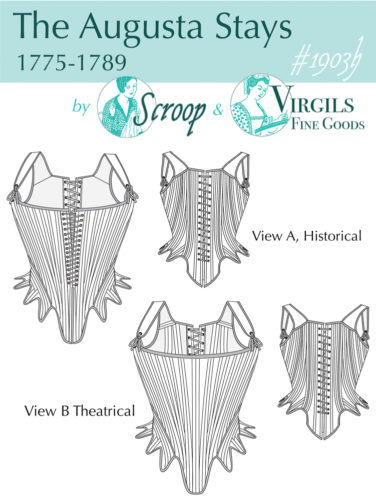
However the cut and boning layout we chose means it is possible to change the shape of the stays with padding and additional structure while you wear them.
The lack of horizontal bones on the Augustas (horizontal bones appear on approximately 50% of extant example of this style of stays) means it’s easier to alter the silhouette of the stays. You can slip a busk down the front between your stays and your shift, and get a more upright 1760s-70s posture. If you’re smaller busted, different styles of bust-padding can make the stays look more 1760-70s, or more extravagantly prow-fronted high-fashion 1780s.
Additionally, how much the stays are going to change your shape depends on your body. Some people have very malleable bodies that change quite a bit with different stays, some people don’t.
Amber has a very squishy body, so she can achieve a fair amount of waist reduction, and alteration in where her bust sits (high, low, pushed to the front, full and rounded to the sides, etc), which makes her shape look more distinctly different from decade to decade. However, as adaptable as her body is, it’s still going to be recognisably her body. You can only change your shape so much.
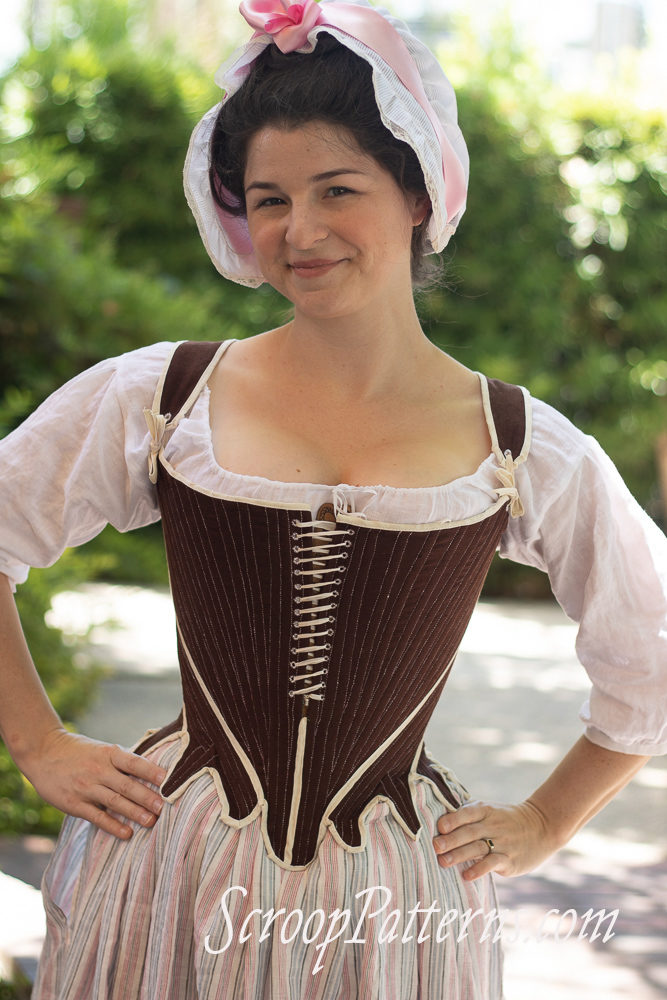
I wear the same size stays as Amber, but have a big ribcage, a small bust, and very little space between my ribcage and hips, so the changes I get from decade to decade are very subtle, and my shape isn’t hugely different in the Augustas or my 1760s stays. Only the most eagle-eyed person, with a background in 18th c silhouettes, and a familiarity with how my body looks in different pairs of stays, would be able to tell that I was wearing my Augusta stays, not another pair, under my 1760s francaise.
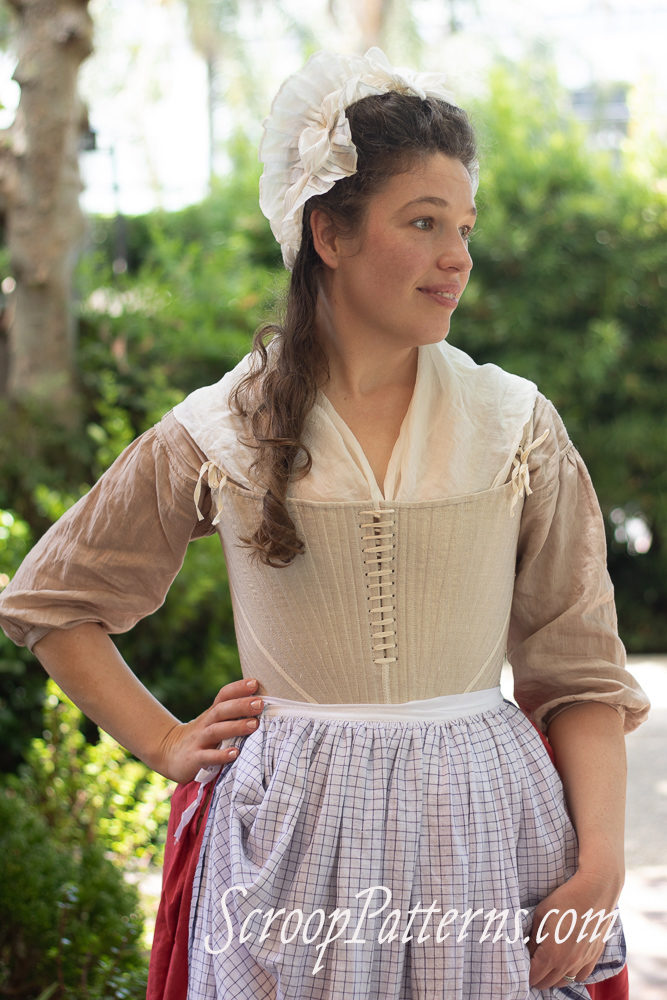
Ultimately, the stays are never going to be a perfect representation of the silhouette of any era except their own. If you’re really dedicated to replicating the most fashionable shape for every decade, you won’t want to use the Augustas for 1750 (for example). However for a costumer doing different decades, with limited ability to own a pair of stays for every decade they could be used as a reasonable all-purpose 18th century pair – especially if you experiment a bit with different busks and padding to change your shape to suit the decade you want to represent.
If I was travelling for an event with limited luggage, and the need to do a bunch of different decades in the 18th c, I would pack my Augustas, instead of my 1760s pair, simply because with a busk and bust pads I can make the Augustas look 1760s-ish, but I can’t make the stiff, upright silhouette of the 1760s even begin to approximate the prow-front of the 1780s.
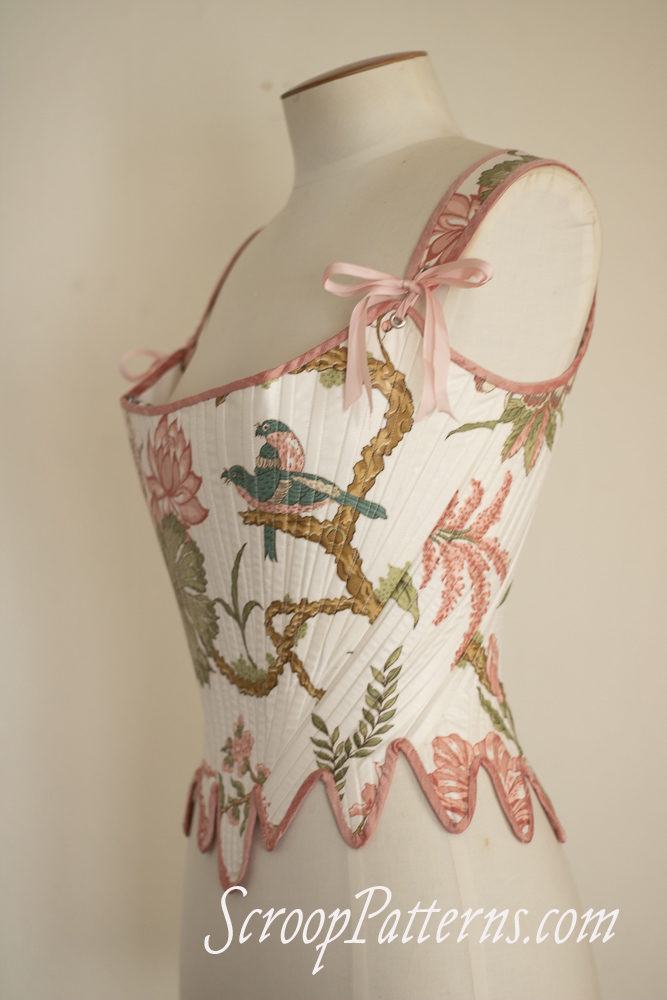
2. Do they have to be boned in synthetic whalebone (German Plastic Boning)? Can I use cane? Or cable ties? What about steel?
The Augusta Stays pattern only includes instructions for working with synthetic whalebone.
However, if you’re familiar with using cane or cable ties, it’s very easy to adapt the pattern to accomodate either of those. You just have to check the width of the boning channels as you sew them, and adjust them if you need them to be a bit wider to fit cane or cable ties.
Cait used cane in her stays, because that’s her preferred boning material:
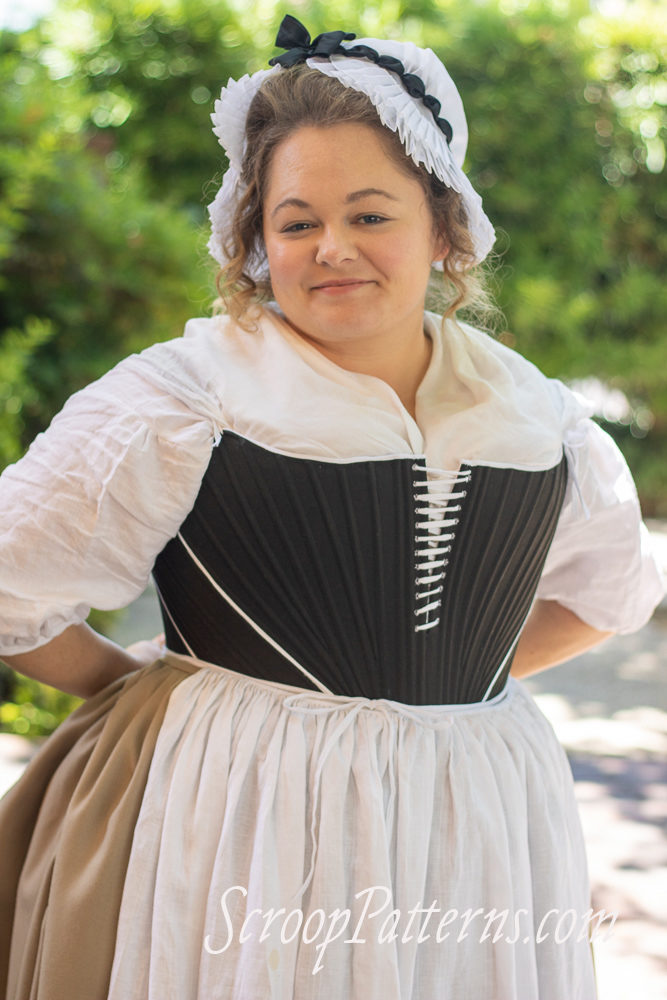
We strongly recommend against using steel bones (spiral or straight) in the Augusta Stays. They will make the stays very heavy, and significantly less comfortable. You also won’t be able to achieve the subtle shaping that really makes the silhouette. Spiral steel won’t provide the right support, and straight steel won’t fit into the curved boning channels.
3. Can the Augusta Stays be made with full front lacing?
Theoretically, yes.
Amber and I haven’t experimented with making the Augustas front lacing, but it should be pretty easy to change the boning layouts slightly, and extend the lacing all the way down the front, so you have front-and-back lacing stays. With careful measuring and a bit of experimenting you could even omit the back lacing, so they were front opening only.
However, you’re unlikely to get as much support, or as much of the desired silhouette, with front lacing stays.
4. Can the Augusta Stays be altered to be strapless?
Absolutely. This is a really easy change: just leave off the straps, and bind the back of the stays where the straps would attach. Don’t worry about the angles at the top of the stays: these appear in extant 1780s stays without straps.
The stays won’t give quite the same ‘shoulders back, front out’ high-fashion shape without straps, but they will still work. You may also find that you don’t get as much back support without straps.
If you do make strapless stays, and decide you don’t like them without straps, you can always make up straps later, bind them separately, and whipstitch them on to your stays.

5. What was the inspiration for including a ‘Theatrical’ version?
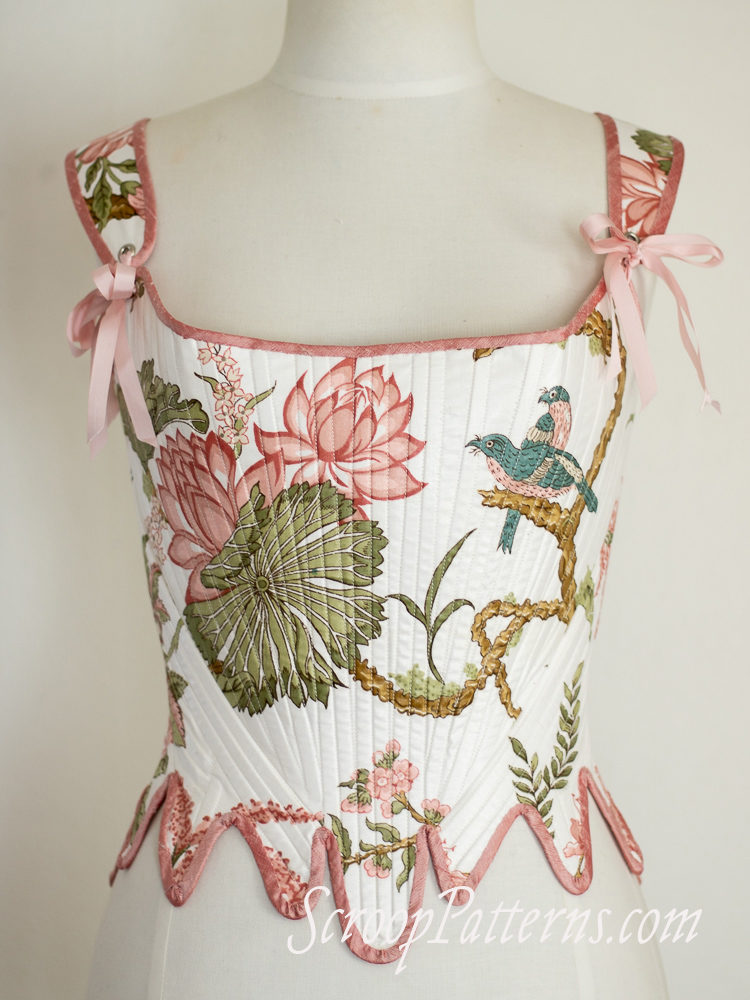
The goal with the Augusta stays was to include full, detailed historically accurate instructions.
But we also realised that some people need stays that give the correct silhouette, but don’t have the time, means, or inclination to do all the handsewing.
So the ‘Theatrical’ version was born. We altered the pattern to remove any elements that are tricky to do without hand-sewing (except the binding, because its even tricker to do by machine without a lot of practice and the right machine), and wrote a full set of instructions for creating the stays by machine, using tips and tricks from theatrical costuming.
The changes to the pattern, the most noticeable of which is removing the front lacing, which requires eyelet holes too small to do except by hand, results in stays that are visually more neutral, and thus easier to adapt for a lot of uses.
Although the silhouette is still basically 1780s (unless you use stays or padding as above), the look is classic 18th century of any decade, so they work for theatre costuming, where strict historical accuracy is often not as important as overall effect.
You can trim and alter the stays to be whatever they need to be. Want a fake stomacher effect on the stays? Can do! Faux front lacing? Not too hard. Steampunk stays or Rococopunk? Totally. They can be anyone from Madame de Pompadour to Little Bo Peep.
While we’re really glad we did the Theatrical version, it did mean writing, illustrating, and editing two completely different sets of instructions It’s basically two full patterns for the price of one…
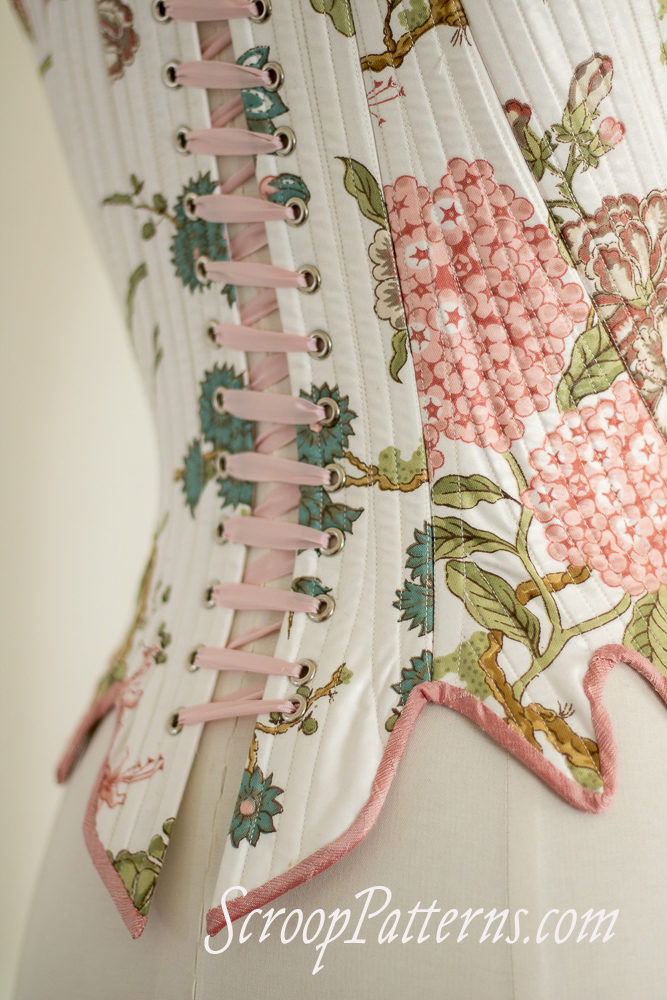
Any more questions? I’ll include them in the next questions post!

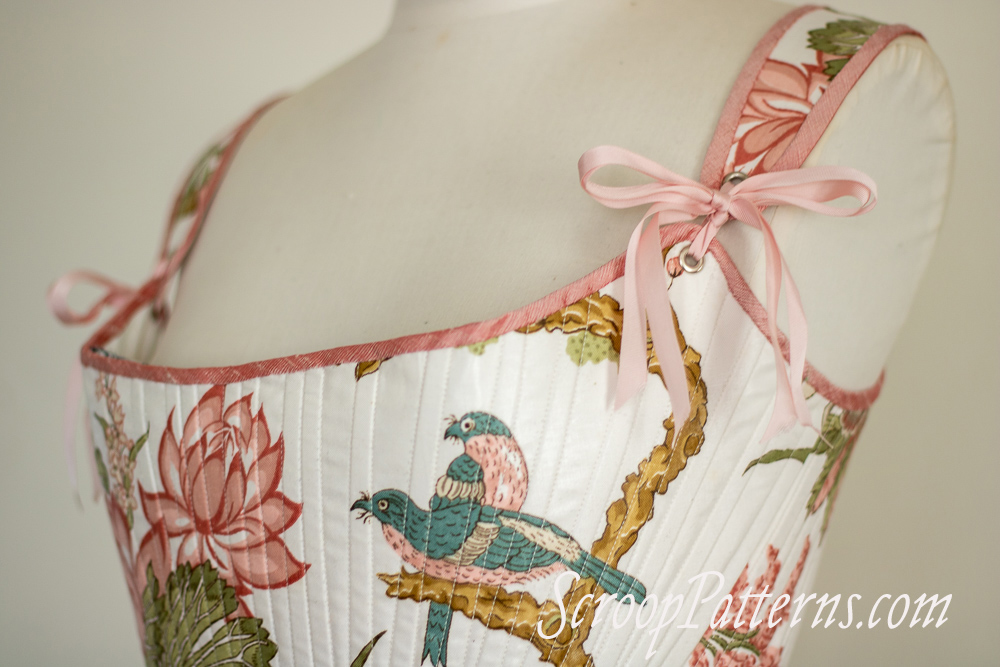
Forgive me–what is the front lacing for?
I”m curious about the same thing. I apparently was completely unaware of this style of stays in the 1780s.
I’ve already got a post about some of the extant stays we used as inspiration scheduled for next week, but now I’m curious. When you thought of 1780s stays, what pairs do you think of?
I specifically raised the question of front lacing because of Czech (and other) folk costume bodices, and because Klára cited to me some edicts (is that the right word?) that asked Czech / Bohemian women to wear front-lacing stays “because it’s the good old modest Czech way”. So apparently in these parts the innovation of back-lacing stays was being frowned upon for regular servant-less folk. 😀
The basic shape is super-similar to all those bodices in the PÅ™Ãbram museum I looked at when I visited her this August – so if one lives in areas where such bodices were worn, with some alterations I think this pattern could work for lower class impressions even well into the 19th century.
Fascinating! When are the edicts about wearing front-lacing stays from? Because it’s amazing how fast something becomes a tradition, and ‘the way it was always done’. The things you hear about white = virginity in wedding dresses and it being so terrible for a bit of petticoat to show below a skirt are both post WWII in UK/US based societies – and yet people assume they date back to the Victorian era. So an edict written in say, 1850 can easily represent an idea/practice that is really only a few decades old.
This shape of stays was definitely worn by less fashionable women until the end of the 18th c, and may have been one of the things that influenced folk dress in a some areas.
It was definitely 18th century – but for the exact dates you’d have to ask Klára. We talked about so many things such small detail escaped my memory. 😀
The bodices we looked at were probably all 19th century and front-lacing, but often had faux-back lacing. Some had tabs, some didn’t; all were lighter-boned than these stays and most consisted of fewer pattern pieces. Some were decidedly practical and worn, some were very decorative; some had bust gussets, but those did not at all seem to be particularly indicative of age.